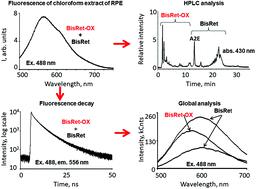当前位置:
X-MOL 学术
›
Photochem. Photobiol. Sci.
›
论文详情
Our official English website, www.x-mol.net, welcomes your
feedback! (Note: you will need to create a separate account there.)
Fluorescence characteristics of lipofuscin fluorophores from human retinal pigment epithelium.
Photochemical & Photobiological Sciences ( IF 2.7 ) Pub Date : 2020-05-18 , DOI: 10.1039/c9pp00406h Marina A Yakovleva 1 , Alexandra Sh Radchenko 1 , Tatiana B Feldman 1, 2 , Alexey A Kostyukov 1 , Patimat M Arbukhanova 3 , Sergey A Borzenok 3 , Vladimir A Kuzmin 1 , Mikhail A Ostrovsky 1, 2
Photochemical & Photobiological Sciences ( IF 2.7 ) Pub Date : 2020-05-18 , DOI: 10.1039/c9pp00406h Marina A Yakovleva 1 , Alexandra Sh Radchenko 1 , Tatiana B Feldman 1, 2 , Alexey A Kostyukov 1 , Patimat M Arbukhanova 3 , Sergey A Borzenok 3 , Vladimir A Kuzmin 1 , Mikhail A Ostrovsky 1, 2
Affiliation

|
Lipofuscin granules accumulate in the retinal pigment epithelium (RPE) with age, especially in patients with visual diseases, including progressive age-related macular degeneration (AMD). Bisretinoids and their photooxidation and photodegradation products are major sources of lipofuscin granule fluorescence. The present study focused on examining the fluorescence decay characteristics of bisretinoid photooxidation and photodegradation products to evaluate the connection between fluorescence lifetime and spectral characteristics of target fluorophore groups. The primary objective of the study was to apply experimental spectral analysis results of lipofuscin granule fluorescence properties to interpretation of fluorescence lifetime imaging ophthalmoscopy data. Fluorescence analysis of the lipofuscin granule fluorophores in RPE collected from cadaver eyes was performed. The fluorescence lifetimes were measured by picosecond-resolved time correlated single photon counting technique. A global analytical method was applied to analyze data sets. The photooxidation and photodegradation products of bisretinoids exhibited a longer fluorescence lifetime (average value approximately 6 ns) and a shorter wavelength maximum (530–580 nm). Further, these products significantly contributed (more than 30%), to total fluorescence compared to the other fluorophores in lipofuscin granules. Thus, the contribution of oxidized lipofuscin bisretinoids to autofluorescence decay kinetics is an important characteristic for fluorescence lifetime imaging microscopy data analysis. The higher average fluorescence lifetime in AMD eyes was likely due to the higher abundance of oxidized bisretinoids compared with non-oxidized bisretinoids. Because higher level of oxidized bisretinoids is indicative of pathological processes in the retina and RPE, the present findings have the potential to improve fluorescence lifetime imaging approaches for early diagnosis of degenerative processes in the retina and RPE.
中文翻译:

人视网膜色素上皮中脂褐素荧光团的荧光特性。
随着年龄的增长,脂褐素颗粒会累积在视网膜色素上皮(RPE)中,尤其是在视力疾病患者中,包括进行性与年龄相关的黄斑变性(AMD)。Bisretinoids及其光氧化和光降解产物是脂褐素颗粒荧光的主要来源。本研究的重点是检查双视黄醛类光氧化和光降解产物的荧光衰减特性,以评估荧光寿命与目标荧光基团的光谱特性之间的联系。该研究的主要目的是将脂褐素颗粒荧光特性的实验光谱分析结果用于解释荧光寿命成像检眼镜数据。对尸体眼中收集到的RPE中的脂褐素颗粒荧光团进行了荧光分析。荧光寿命通过皮秒分辨时间相关的单光子计数技术测量。一种全局分析方法被应用于分析数据集。双维甲酸的光氧化和光降解产物表现出更长的荧光寿命(平均值约为6 ns)和更短的波长最大值(530-580 nm)。此外,与脂褐素颗粒中的其他荧光团相比,这些产品对总荧光有显着贡献(超过30%)。因此,氧化脂褐素双维甲酸对自发荧光衰减动力学的贡献是荧光寿命成像显微镜数据分析的重要特征。与未氧化的类视黄醇相比,氧化的类视黄醇含量更高,因此AMD眼睛的平均荧光寿命更长。因为较高水平的氧化双视黄醛类化合物指示视网膜和RPE中的病理过程,所以本研究结果具有改善荧光寿命成像方法的潜力,可早期诊断视网膜和RPE中的变性过程。
更新日期:2020-07-15
中文翻译:

人视网膜色素上皮中脂褐素荧光团的荧光特性。
随着年龄的增长,脂褐素颗粒会累积在视网膜色素上皮(RPE)中,尤其是在视力疾病患者中,包括进行性与年龄相关的黄斑变性(AMD)。Bisretinoids及其光氧化和光降解产物是脂褐素颗粒荧光的主要来源。本研究的重点是检查双视黄醛类光氧化和光降解产物的荧光衰减特性,以评估荧光寿命与目标荧光基团的光谱特性之间的联系。该研究的主要目的是将脂褐素颗粒荧光特性的实验光谱分析结果用于解释荧光寿命成像检眼镜数据。对尸体眼中收集到的RPE中的脂褐素颗粒荧光团进行了荧光分析。荧光寿命通过皮秒分辨时间相关的单光子计数技术测量。一种全局分析方法被应用于分析数据集。双维甲酸的光氧化和光降解产物表现出更长的荧光寿命(平均值约为6 ns)和更短的波长最大值(530-580 nm)。此外,与脂褐素颗粒中的其他荧光团相比,这些产品对总荧光有显着贡献(超过30%)。因此,氧化脂褐素双维甲酸对自发荧光衰减动力学的贡献是荧光寿命成像显微镜数据分析的重要特征。与未氧化的类视黄醇相比,氧化的类视黄醇含量更高,因此AMD眼睛的平均荧光寿命更长。因为较高水平的氧化双视黄醛类化合物指示视网膜和RPE中的病理过程,所以本研究结果具有改善荧光寿命成像方法的潜力,可早期诊断视网膜和RPE中的变性过程。











































 京公网安备 11010802027423号
京公网安备 11010802027423号